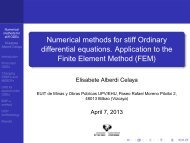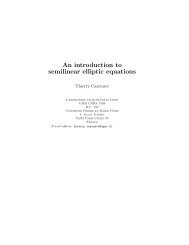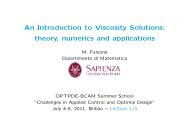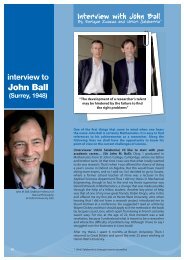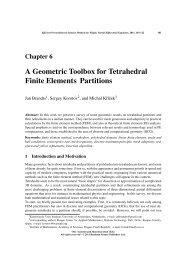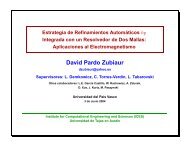High-order mixed weighted compact and non-compact scheme for ...
High-order mixed weighted compact and non-compact scheme for ...
High-order mixed weighted compact and non-compact scheme for ...
Create successful ePaper yourself
Turn your PDF publications into a flip-book with our unique Google optimized e-Paper software.
The only parameter left undetermined so far in the final expression of WCNC <strong>scheme</strong> (2.11) is ,which is crucial <strong>for</strong> the <strong>scheme</strong>s’ per<strong>for</strong>mance. The parameter is determined in relation to thesmoothness of the function. As mentioned, the basic idea is to recover the st<strong>and</strong>ard <strong>compact</strong> <strong>scheme</strong>(2.1) in smooth regions, taking advantage of global dependency of the <strong>compact</strong> <strong>scheme</strong> <strong>for</strong> achievinghigh <strong>order</strong>, <strong>and</strong> to reassemble a lower <strong>order</strong> <strong>scheme</strong>, <strong>non</strong>-<strong>compact</strong>, in regions where discontinuities arepresent. Thus the role of the parameter is to assume the value 1/3 in smooth regions, <strong>and</strong> to rangefrom zero to 1/3 according to the smoothness of the function.In this preliminary study, the <strong>for</strong>mulation adopted is the following = 1 − µ + µ 1 3where µ is a fixed parameter (µ = 0.95 in the present study), <strong>and</strong> = 1 3 − 1 2 − 1 3 + − 1 3 + − 1 3 (2.12)(2.13)The normalized smoothness parameters are = + + (2.14)In smooth regions, the three normalized smoothness parameters are nearly equal, namely ≅ ≅ ≅ 1/3, thus ≅ 1/3 <strong>and</strong> also ≅ 1/3, <strong>and</strong> the sixt-<strong>order</strong> st<strong>and</strong>ard <strong>compact</strong> <strong>scheme</strong> isrecovered achieving global dependency <strong>and</strong> the best resolution. In shock/discontinuity regions, theworst case leads to dramatically different weights <strong>for</strong> the stencils. For instance, if = 1 <strong>and</strong> = = 0, the parameter = 0, so that the local dependency is introduced in the <strong>scheme</strong> <strong>and</strong> <strong>non</strong>oscillatoryproperty is achieved.Apparently, the WCNC <strong>scheme</strong> relies heavily on the function which controls the mixing between the<strong>non</strong> dissipative st<strong>and</strong>ard <strong>compact</strong> <strong>scheme</strong> <strong>for</strong> smooth regions, <strong>and</strong> the dissipative <strong>non</strong>-<strong>compact</strong> <strong>scheme</strong><strong>for</strong> shock areas. The approach <strong>for</strong> finding the optimum α in relation to the smoothness of the functionwill be subject of future study.3.1 Numerical resultsNumerical simulations of test cases are carried out using the proposed WCNC <strong>scheme</strong>, <strong>and</strong> comparedwith WCS (Jiang, et al., 2001) <strong>and</strong> the well established WENO (Jiang, et al., 1996). The proposed WCNC<strong>scheme</strong> is used in solving the Euler 1-D equations + = 0 = , , (3.1.1) = , + , + 7



